A.R. Simmons's Blog: Musings and Mutterings, page 4
November 27, 2020
Legendary Detectives, Charlie Chan

Say “Charlie Chan” and duck. A brickbat is on the way as soon as you mention Earl Derr Biggers’s Chinese-American detective. Yes, I know about demeaning stereotypes—scratch that and just say “stereotypes.” They are all demeaning. However, please try to judge an author, a book, a character, even a stereotype in the setting of the era to which they belong.
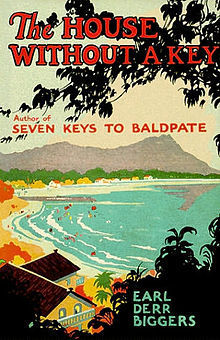
The House Without A Key is an old fashioned murder mystery in which Earl Der Biggers introduces us to both early 20th century Hawaii and the finest detective on the police department, Charlie Chan. In the book, Chan is not the main character, but he plays the pivotal role.
The author also presents the cultural diversity of the island territory. This is a successful launch of career for a detective beloved by readers and much more so by movie goers.
Chan emerges as a non-threatening, amiable, hyphenated American possessed of the supposedly "oriental" traits: stoicism and quiet persistence.
George Kuwa a Japanese-American was the first to portray Chan in movies. The House Without a Key. (1926) pic below
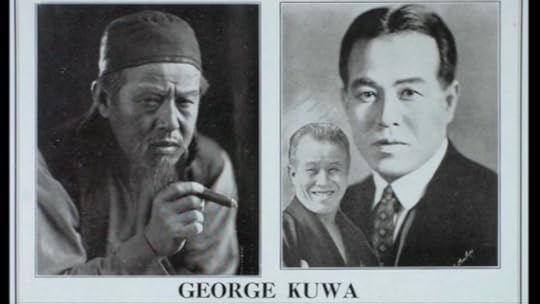
Every new hero needs a hook, something that makes him interestingly unique. Der Biggers gave Chan his ethnicity as an arresting image. At the time, the stereotype of the "Yellow Peril" was widespread in the US (think Fu Manchu).
Charlie Chan was the "benign" half of the stereotype. He was the wily, inscrutable, proverb-uttering Chinaman. His flawed syntactic English was a sop to the genteel bigotry of early 20th century American culture. It made him "acceptable" in the same way as employing the Swedish actor Warner Oland to portray him in most of the movies.
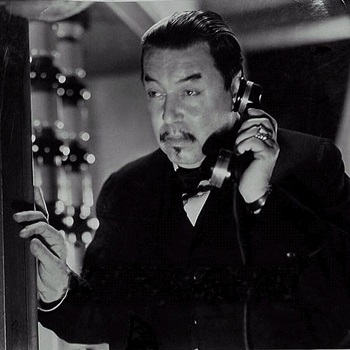
So we have the faux Confucius proverbs spoken to explain his thinking and the eventual undoing of the criminals he brought to justice. Chan was so beloved that virtually all children in the US grew up with a panoply of "Confucius say . . ." one-liners. The thing about "benign" stereotypes is that they are unconscious and not at all intended to offend—yet they did and do.
Still, Der Biggers' Chinese-American sleuth adds something new to the detective genre—humor. Charlie Chan gives us perhaps more humor than any of his predecessors.
He is an engaging man, not at all the "wily Oriental gentleman" of British colonial stereotyping . His charm lies in his use of aphoristic wisdom stated in faux-Confusion sayings. Chan actually is a sort of classic sage.
Sometimes he uses his “proverbs” to reveal what he has deduced and to explain motives, but also uses them to respond to the prejudice that he encounters. He is wise, calm, and as proper at Hercule Poroit. And like Poroit and Father Brown, he deliberately lets people underestimate him.
The House Without a Key
Published on November 27, 2020 06:44
•
Tags:
detectives, mystery, sleuths
November 18, 2020
1918 (written in stone)
My wife and I are local history buffs. A few years ago we became interested in the many "named places" scattered throughout the Ozark foothills where we live. I'm sure the rural areas near your homes are replete with these ghost towns and former hamlets where nothing but memories and notations in a gazetteer now exists. Many of them were old railroad stops, lumber sites, or post offices.
This is all very interesting to history buffs, but perhaps not so much to everyone else. However, in our many day trips we noticed something that should be of current interest: the huge number of headstones in the overgrown and untended graveyards with the death dates of 1918-1919. That hundred-year-old plague year should be very interesting to us who are living through the current plague year. Whether we like it or not, whether we believe it or not, the gravestones of 2020 and 2021 will tell the tale.
It will be written in stone.
This is all very interesting to history buffs, but perhaps not so much to everyone else. However, in our many day trips we noticed something that should be of current interest: the huge number of headstones in the overgrown and untended graveyards with the death dates of 1918-1919. That hundred-year-old plague year should be very interesting to us who are living through the current plague year. Whether we like it or not, whether we believe it or not, the gravestones of 2020 and 2021 will tell the tale.
It will be written in stone.
November 3, 2020
Legendary Detectives, Father Brown

Dupin introduced us to the gentleman detective using keen observation, precise reasoning, and mind-hunting via creative imagination to solve crimes. Sherlock Holmes took observation and single-minded obsession to new heights, ridding himself of emotion to apply cold, sharp logic. He added fingerprint, footprint, trace evidence examination, chemical analysis, and postmortem examination to his toolkit. He was the prototypical CSI.
Inevitably, a detective came along who, while logical, employed the less tidy side of his brain, the intuitive faculty. G. K. Chesterton introduced us to Father Brown in “The Blue Cross” (1910). Poe and Conan Doyle gave us the “man of leisure” prototype of detective; Chesterton gave us the “cleric/detective” common in the Cozy Mystery genre. The first compilation of Chesterton’s short stories, “The Innocence of Father Brown,” was published in 1911. Four more compilations followed, the last in 1935.
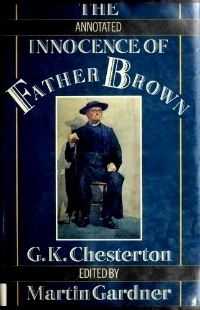
At first glance, it seems odd that a cloistered “man of the cloth” should immerse himself in ugly mayhem and ungodly crimes. Chesterton, however, asks who is privy to more sins and crimes than a minister? How innocent of ugliness can a man be who occupies the confessional? A priest is not a hermit monk who has withdrawn from the world.
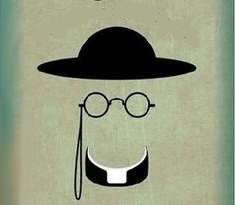
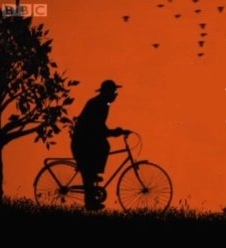
Let’s take a look at Chesterton’s hero. He is a humble man, given to deep thought but few words.
Father Brown’s appearance decidedly does not inspire confidence, much less fear. He is a short, stocky, dough-faced Roman Catholic priest, who wears pince nez glasses, a capello Romano priest’s hat, and rumpled clothes. Always at hand is a large umbrella, even as he rides about the parish on his bicycle. His aspect leads people to underestimate him, a device used later by the slovenly-dressed TV detective, Colombo (portrayed by Peter Falk).
So what does Father Brown bring to the table?
What is his method?
What becomes apparent is that the unassuming priest has a vast knowledge of human nature. He has been exposed to as much evil as any policeman—intimately exposed. His toolkit consists of a keen understanding of people, their foibles, temptations, and failures. The cleric tends to intuition more than deductive reasoning, although he employs both. He observes carefully and applies logic, but he primarily “feels” his way to the solution of the crime.
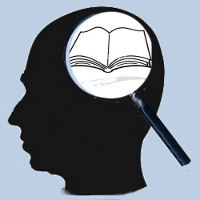
Dupin and Holmes hint at profiling, but Father Brown is a bona fide “mind-hunter.” He reconstructs the crime in order to get inside the mind of the criminal. In fact, he becomes the murderer (in his mind) and imagines committing the crime. When he gets firmly into the psyche of the criminal, he sees who it is. This is not a fey thing, however, not a séance, nor divine revelation. Father Brown always produces a rational explanation of the crime, and he details the criminal’s motivation.
One final note: don’t think that Father Brown is a man with nothing better to do than gallivant around the parish seeking diversion with juicy murder cases. He is a serious priest, devoted to his church and duties.
The Innocence of Father Brown
Published on November 03, 2020 06:21
•
Tags:
cozy, crime-fiction, detective-fiction, genre-fiction
September 18, 2020
The Detective Genre, # 2
The CSI

In the initial Legendary Detectives post, we looked at Poe’s C, August Dupin, introduced in the 1840s story “Murders in the Rue Morgue.” Now we turn to the most famous detective of all time, Sherlock Holmes. Perhaps I can stir your memory or provoke you into reconsidering your image of Sir Arthur Conan Doyle's iconic "consulting detective." The problem for us is that Sherlock Holmes has been portrayed by so many actors, and in so many movies and TV episodes, that our present view of him differs from the original character.
Conan Doyle introduces him in "A Study In Scarlet," published in Beeton's Christmas Annual in November of 1887. He continues to flesh him out in adventures published in The Strand magazine. Eventually, the mysteries total 56 short stories and four novels. In these, the author produces a detailed and consistent physical, emotional, and psychological portrait of the first great detective.
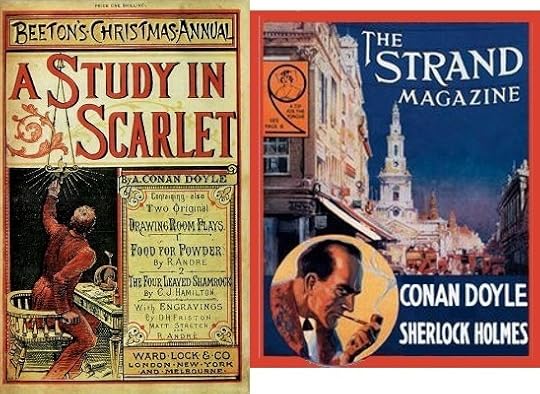
Unlike Poe’s paucity of detail as to Dupin’s appearance, Conan Doyle is quite precise in his physical description of Holmes. That’s good because so many actors have portrayed him that we may have a different picture of the man than the stories describe.
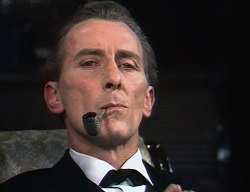
The author paints Holmes as a tall and lean black-haired man with piercing gray eyes beneath heavy dark-brown eyebrows. Thin firm lips and a hawk nose complete the thin intense face. He has sinewy arms and long thin fingers. His appearance is angular and wiry to the extreme. For me, the closest match among his portrayers was Peter Cushing. Compare the photo with the painting of Holmes on the Strand cover above.
I’ll not draw conclusions about Holmes's psyche, but only catalog what comes through the stories. He says of himself, "I use my head, not my heart." He abhors emotion as an impediment to rational thought, hence his aversion of women (whom he considers emotional as well as emotion-producing). Perhaps this also explains his disinclination to form new friendships. He has no time for small talk and casual acquaintances. He plays the violin, but otherwise has no interest in the arts (literature included—unless it is sensationalist press stories about mayhem and horror). Holmes is egotistical in the extreme, having no patience for lesser intellects and open contempt for inferior minds. He is cold, precise, and didactic in stating his conclusions. That could be tiring, but it's not.
Holmes is often restless, obsessive, and impatient. At other times, he is consumed with intense ennui which he escapes via drugs that were legal at the time: the famous seven-per cent solution of cocaine and morphine. Is it that his mind needs a puzzle to throw his switch on a bipolar disorder? Or is he, as Benedict Cumberbatch has him say, a “high-functioning sociopath?” I don’t know, but Conan Doyle would never have considered such things. In his day, psychiatrists were “alienists” and psychological disorders might be termed “fevers of the brain.” Holmes is what he is: an extreme enthusiast, at times insufferable, but vastly interesting.
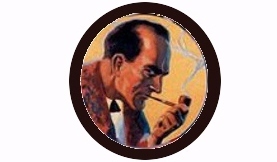
But it's all about method, isn't it?
So what is the Holmes method?
How can he see things as so “elementary?”
To what extent Conan Doyle modeled Sherlock Holmes on Poe's Dupin is a matter of conjecture. Like the strange French detective, Holmes is preternaturally observant, not only of crime scene clues, but of facial expressions, body language, speaking mannerisms and inflections as well as other "tells." Neither miss details that others discount or fail to observe.
Both men are “human lie detectors.” They “cold read” so well that they seem to read minds. Each uses “creative imagination” to get into the minds and understand the actions of the perpetrator. However, Dupin relies on it, while Holmes relies on cold reason. Holmes is also a pioneer in forensic science. Doyle even has him author treatises on innovative CSI work. He breaks the case using logic, deduction, and science. And all of this began in an age when the official investigators were only becoming aware of the CSI tools that Holmes employed.
If he did not invent the mystery genre, Sir Arthur Conan Doyle certainly defined it for decades to come. Moreover, he was the prophet of real-life crime detection much as another Brit, Arthur C. Clarke, was the prophet of space science technology.
A Study in Scarlet

In the initial Legendary Detectives post, we looked at Poe’s C, August Dupin, introduced in the 1840s story “Murders in the Rue Morgue.” Now we turn to the most famous detective of all time, Sherlock Holmes. Perhaps I can stir your memory or provoke you into reconsidering your image of Sir Arthur Conan Doyle's iconic "consulting detective." The problem for us is that Sherlock Holmes has been portrayed by so many actors, and in so many movies and TV episodes, that our present view of him differs from the original character.
Conan Doyle introduces him in "A Study In Scarlet," published in Beeton's Christmas Annual in November of 1887. He continues to flesh him out in adventures published in The Strand magazine. Eventually, the mysteries total 56 short stories and four novels. In these, the author produces a detailed and consistent physical, emotional, and psychological portrait of the first great detective.

Unlike Poe’s paucity of detail as to Dupin’s appearance, Conan Doyle is quite precise in his physical description of Holmes. That’s good because so many actors have portrayed him that we may have a different picture of the man than the stories describe.

The author paints Holmes as a tall and lean black-haired man with piercing gray eyes beneath heavy dark-brown eyebrows. Thin firm lips and a hawk nose complete the thin intense face. He has sinewy arms and long thin fingers. His appearance is angular and wiry to the extreme. For me, the closest match among his portrayers was Peter Cushing. Compare the photo with the painting of Holmes on the Strand cover above.
I’ll not draw conclusions about Holmes's psyche, but only catalog what comes through the stories. He says of himself, "I use my head, not my heart." He abhors emotion as an impediment to rational thought, hence his aversion of women (whom he considers emotional as well as emotion-producing). Perhaps this also explains his disinclination to form new friendships. He has no time for small talk and casual acquaintances. He plays the violin, but otherwise has no interest in the arts (literature included—unless it is sensationalist press stories about mayhem and horror). Holmes is egotistical in the extreme, having no patience for lesser intellects and open contempt for inferior minds. He is cold, precise, and didactic in stating his conclusions. That could be tiring, but it's not.
Holmes is often restless, obsessive, and impatient. At other times, he is consumed with intense ennui which he escapes via drugs that were legal at the time: the famous seven-per cent solution of cocaine and morphine. Is it that his mind needs a puzzle to throw his switch on a bipolar disorder? Or is he, as Benedict Cumberbatch has him say, a “high-functioning sociopath?” I don’t know, but Conan Doyle would never have considered such things. In his day, psychiatrists were “alienists” and psychological disorders might be termed “fevers of the brain.” Holmes is what he is: an extreme enthusiast, at times insufferable, but vastly interesting.

But it's all about method, isn't it?
So what is the Holmes method?
How can he see things as so “elementary?”
To what extent Conan Doyle modeled Sherlock Holmes on Poe's Dupin is a matter of conjecture. Like the strange French detective, Holmes is preternaturally observant, not only of crime scene clues, but of facial expressions, body language, speaking mannerisms and inflections as well as other "tells." Neither miss details that others discount or fail to observe.
Both men are “human lie detectors.” They “cold read” so well that they seem to read minds. Each uses “creative imagination” to get into the minds and understand the actions of the perpetrator. However, Dupin relies on it, while Holmes relies on cold reason. Holmes is also a pioneer in forensic science. Doyle even has him author treatises on innovative CSI work. He breaks the case using logic, deduction, and science. And all of this began in an age when the official investigators were only becoming aware of the CSI tools that Holmes employed.
If he did not invent the mystery genre, Sir Arthur Conan Doyle certainly defined it for decades to come. Moreover, he was the prophet of real-life crime detection much as another Brit, Arthur C. Clarke, was the prophet of space science technology.
A Study in Scarlet
Published on September 18, 2020 06:27
•
Tags:
amateur-sleuths, detectives, mystery
September 9, 2020
The Detective Genre, # 1
The Amateur Sleuth

I love mysteries. Nothing is more fun than becoming one of my favorite detectives with a good puzzle to solve. I know that most crime is uncomplicated. The bulk of it is stupid, banal, and squalid. There is little criminal genius in the real world, and our Moriartys are up to financial fraud, not “murder most foul.” Still, I can, and do, suspend disbelief gladly when I pick up a new novel or short story because I love being an investigator, a profiler, a criminologist, or a forensic expert—a sleuth of any stripe.
In this series of posts, I want to share with you some of my encounters with legendary detectives. I’ve followed some closely, been briefly introduced to others, but only know some by reputation. Let me share a few interesting things I know about them. I’m sure that you can list others that I will not include. And I’m equally sure that you know things about each of them that I will fail to mention. This list is a personal one. I make no claim to authority. As with all “best lists,” people will differ. That’s great. As they say, “a difference of opinions is what makes a horse race.”
Jonathan Kellerman has Alex Delaware remark that his friend Milo Sturgis is the only detective he knows that has actually detected anything. A detective goes about detecting by collecting physical evidence and asking questions. This “legwork,” is time-consuming whenever he gets a case without an obvious “who” that “did it.” Real life detectives handle such cases but rarely. The fictional ones do it every time, or else there would be no story for us to climb into.
Let’s take a look at the first detective, Edgar Allen Poe’s C. Auguste Dupin from “The Murders in the Rue Morgue” (1841), and “The Mystery of Marie Rogêt” (1842), followed by “The Purloined Letter” (1844). (I’ll not argue whether other detectives have a better claim to being first. If we have a difference of opinion, that’s good. It makes for stimulating conversation.)
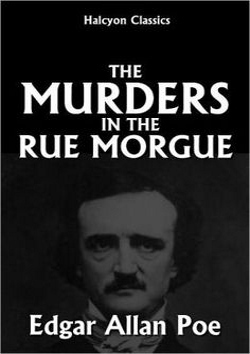
C. Auguste Dupin
A professional detective, be he a cop or a private investigator, has time for the extensive legwork required because that’s the job. Amateur detectives, however, must find the time and have the money to pursue their cases. That’s why mystery writers often create detectives who are people of leisure with adequate resources. History supplies us with just such people. Beginning during the scientific revolution of the 17th century and continuing through the 19th century, some gentlemen of the nobility devoted their time, resources, and energy to advancing scientific knowledge. Robert Boyle, Henry Cavendish, and Antoine Lavoisier were of the nobility. Charles Darwin was a wealthy and connected doctor’s son. So when Poe chose a man of leisure for his detective, he followed historical precedent.
The narrator who introduces Le Chevalier (Sir) C. Auguste Dupin calls him “that unusual Frenchman.” Dupin’s once-rich noble family has apparently left him only modest means and its prestigious rank. He is a socially unattached man and eccentric. His life is books and a voyeuristic interest in the people among whom he moves with minimal and shallow interaction. He is coldly rational, egotistical, intellectually snobbish, and abrupt to the point of rudeness. Dupin is all brains and no soul. How that works with his being an amateur poet, I have no idea. He is obsessed with puzzles and enigmas. He doesn’t really care for abstracts like “justice.” Nor does he worry overmuch about the falsely-accused. He burns to solve the case for the mere satisfaction of solving it. In short, he’s brilliant and interesting, but not a nice guy. Does that sound like another detective you know? (Hint: he also has a sidekick who chronicles his cases.)
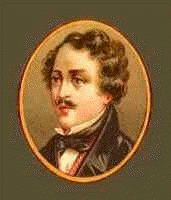 So how does this genius go about the job? He collects facts and then uses both sides of his brain. He pays intense attention to the details, especially the ones that seem to make no sense. He also notices what people do not say as well as what they do say. Dupin is adept at reading people. He notes their hesitations, their manner, their expressions, and their body language. You wouldn’t want to play poker with this strange fellow. The exact “how” leads to an understanding of the “why” which reveals the “who.” He applies a combination of cold logic and creative imagination to get into the head of the criminal. I suppose that makes him the first profiler as well as the first detective.
So how does this genius go about the job? He collects facts and then uses both sides of his brain. He pays intense attention to the details, especially the ones that seem to make no sense. He also notices what people do not say as well as what they do say. Dupin is adept at reading people. He notes their hesitations, their manner, their expressions, and their body language. You wouldn’t want to play poker with this strange fellow. The exact “how” leads to an understanding of the “why” which reveals the “who.” He applies a combination of cold logic and creative imagination to get into the head of the criminal. I suppose that makes him the first profiler as well as the first detective.
The Murders in the Rue Morgue

I love mysteries. Nothing is more fun than becoming one of my favorite detectives with a good puzzle to solve. I know that most crime is uncomplicated. The bulk of it is stupid, banal, and squalid. There is little criminal genius in the real world, and our Moriartys are up to financial fraud, not “murder most foul.” Still, I can, and do, suspend disbelief gladly when I pick up a new novel or short story because I love being an investigator, a profiler, a criminologist, or a forensic expert—a sleuth of any stripe.
In this series of posts, I want to share with you some of my encounters with legendary detectives. I’ve followed some closely, been briefly introduced to others, but only know some by reputation. Let me share a few interesting things I know about them. I’m sure that you can list others that I will not include. And I’m equally sure that you know things about each of them that I will fail to mention. This list is a personal one. I make no claim to authority. As with all “best lists,” people will differ. That’s great. As they say, “a difference of opinions is what makes a horse race.”
Jonathan Kellerman has Alex Delaware remark that his friend Milo Sturgis is the only detective he knows that has actually detected anything. A detective goes about detecting by collecting physical evidence and asking questions. This “legwork,” is time-consuming whenever he gets a case without an obvious “who” that “did it.” Real life detectives handle such cases but rarely. The fictional ones do it every time, or else there would be no story for us to climb into.
Let’s take a look at the first detective, Edgar Allen Poe’s C. Auguste Dupin from “The Murders in the Rue Morgue” (1841), and “The Mystery of Marie Rogêt” (1842), followed by “The Purloined Letter” (1844). (I’ll not argue whether other detectives have a better claim to being first. If we have a difference of opinion, that’s good. It makes for stimulating conversation.)

C. Auguste Dupin
A professional detective, be he a cop or a private investigator, has time for the extensive legwork required because that’s the job. Amateur detectives, however, must find the time and have the money to pursue their cases. That’s why mystery writers often create detectives who are people of leisure with adequate resources. History supplies us with just such people. Beginning during the scientific revolution of the 17th century and continuing through the 19th century, some gentlemen of the nobility devoted their time, resources, and energy to advancing scientific knowledge. Robert Boyle, Henry Cavendish, and Antoine Lavoisier were of the nobility. Charles Darwin was a wealthy and connected doctor’s son. So when Poe chose a man of leisure for his detective, he followed historical precedent.
The narrator who introduces Le Chevalier (Sir) C. Auguste Dupin calls him “that unusual Frenchman.” Dupin’s once-rich noble family has apparently left him only modest means and its prestigious rank. He is a socially unattached man and eccentric. His life is books and a voyeuristic interest in the people among whom he moves with minimal and shallow interaction. He is coldly rational, egotistical, intellectually snobbish, and abrupt to the point of rudeness. Dupin is all brains and no soul. How that works with his being an amateur poet, I have no idea. He is obsessed with puzzles and enigmas. He doesn’t really care for abstracts like “justice.” Nor does he worry overmuch about the falsely-accused. He burns to solve the case for the mere satisfaction of solving it. In short, he’s brilliant and interesting, but not a nice guy. Does that sound like another detective you know? (Hint: he also has a sidekick who chronicles his cases.)
 So how does this genius go about the job? He collects facts and then uses both sides of his brain. He pays intense attention to the details, especially the ones that seem to make no sense. He also notices what people do not say as well as what they do say. Dupin is adept at reading people. He notes their hesitations, their manner, their expressions, and their body language. You wouldn’t want to play poker with this strange fellow. The exact “how” leads to an understanding of the “why” which reveals the “who.” He applies a combination of cold logic and creative imagination to get into the head of the criminal. I suppose that makes him the first profiler as well as the first detective.
So how does this genius go about the job? He collects facts and then uses both sides of his brain. He pays intense attention to the details, especially the ones that seem to make no sense. He also notices what people do not say as well as what they do say. Dupin is adept at reading people. He notes their hesitations, their manner, their expressions, and their body language. You wouldn’t want to play poker with this strange fellow. The exact “how” leads to an understanding of the “why” which reveals the “who.” He applies a combination of cold logic and creative imagination to get into the head of the criminal. I suppose that makes him the first profiler as well as the first detective.The Murders in the Rue Morgue
Published on September 09, 2020 03:05
•
Tags:
amateur-sleuths, detectives, mystery
May 1, 2020
They Twain Shall Be One Flesh; Richard and Jill Carter
Musings
By the third book (Canaan Camp) Richard and Jill have become "life partners." They are complementary halves of a whole, each supplying what the other lacks. Or perhaps a better way to put it is that they are a Gestalt, being together more than they are alone.
It seems at first glance that Richard is the main beneficiary of this "partnership," but on closer inspection we see that Jill needs him as much as he needs her. And the cause is emotional trauma along with the common situation that we all find ourselves in: Life is a rough journey and no one can go it completely alone.
Jill is more educated and intelligent than Richard in many ways, but life has equipped him with skills that she does not possess. He may be stronger than she is, but she is tougher than he. Yet their union and strength is tenuous.
Then came Mirabelle. A threefold chord is not easily broken.

A.R. Simmons
By the third book (Canaan Camp) Richard and Jill have become "life partners." They are complementary halves of a whole, each supplying what the other lacks. Or perhaps a better way to put it is that they are a Gestalt, being together more than they are alone.
It seems at first glance that Richard is the main beneficiary of this "partnership," but on closer inspection we see that Jill needs him as much as he needs her. And the cause is emotional trauma along with the common situation that we all find ourselves in: Life is a rough journey and no one can go it completely alone.
Jill is more educated and intelligent than Richard in many ways, but life has equipped him with skills that she does not possess. He may be stronger than she is, but she is tougher than he. Yet their union and strength is tenuous.
Then came Mirabelle. A threefold chord is not easily broken.

A.R. Simmons
Published on May 01, 2020 03:43
•
Tags:
life-partners, marriage, murder, mystery, ptsd, serial-killer, strong-female-character, suspense
April 4, 2020
The Evolution of The Richard Carter Series; #2 Cold Tears
COLD TEARS takes the Carters to the small town of James Mill in the Missouri Ozarks, where Jill has secured a graduate assistant position at Missouri State. Richard’s PTSD after adding the death of Mic Boyd has intensified his guilt and depression over what happened while he was a Marine in Somalia.

Their marriage is in trouble until a tragic disappearance throws Richard a lifeline by giving him an opportunity to be an amateur sleuth. Jill fears that finding the truth might be the blow that destroys him. All the while she struggles to support him and save their marriage.
In this story Richard demonstrates his investigative “genius.” He is persistent to the point of being obsessive-compulsive. Jill shows her strength and determination. Competing for her husband’s attention is another strong and determined woman. I confess that I am partial to strong female characters.
Set in my native Ozarks, this novel was great fun to write. I hope you will enjoy getting to know the Carters while trying to discover the truth Richard is seeking.

Their marriage is in trouble until a tragic disappearance throws Richard a lifeline by giving him an opportunity to be an amateur sleuth. Jill fears that finding the truth might be the blow that destroys him. All the while she struggles to support him and save their marriage.
In this story Richard demonstrates his investigative “genius.” He is persistent to the point of being obsessive-compulsive. Jill shows her strength and determination. Competing for her husband’s attention is another strong and determined woman. I confess that I am partial to strong female characters.
Set in my native Ozarks, this novel was great fun to write. I hope you will enjoy getting to know the Carters while trying to discover the truth Richard is seeking.
Published on April 04, 2020 03:39
•
Tags:
murder, mystery, serial-killer, strong-female-character, suspense
March 24, 2020
Quarantine Reading
Please stay safe and keep others safe too. Pray for the best and prepare for the worst. We are all in this together from the Concrete Canyons of the brave New Yorkers to the eroded plateau called the Ozark Mountains where we "hill folk" live.
What better way to spend forced isolation than by booking passage on Bronte's frigate?
Read. Immerse yourself in another world.
Discuss books of your favorite genre with your own cyber book club or just a like-minded friend.
For the duration I am offering my mystery/suspense series as half-price Kindle books ($.99).

I also will offer free for 5 days (3/28-4/1) the latest book in the series The Playpretty.
To find my Amazon author page search Blue Creek Novels and then click on the crow.

What better way to spend forced isolation than by booking passage on Bronte's frigate?
Read. Immerse yourself in another world.
Discuss books of your favorite genre with your own cyber book club or just a like-minded friend.
For the duration I am offering my mystery/suspense series as half-price Kindle books ($.99).

I also will offer free for 5 days (3/28-4/1) the latest book in the series The Playpretty.
To find my Amazon author page search Blue Creek Novels and then click on the crow.

Published on March 24, 2020 04:29
•
Tags:
murder, mystery, serial-killer, strong-female-character, suspense
November 25, 2019
This Ozark Boy’s First Smoke
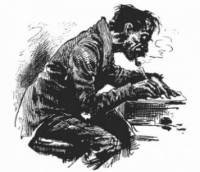
Our neighborhood consisted of my family. We lived just down the road from Grandma and Grandpa, Uncle Clarence and Aunt Mary up the road, and Uncle Benton and Aunt Zelma across the road from them. Saturday was shopping day (we didn’t waste gas on needless driving). We kids begged to stay home rather than sit in the car while our parents bought the week’s groceries.
Now kids left to themselves will find mischief. It’s a law of nature, and as I recall, my cousins and I were quite good at it. One Saturday when left at home, we decided to smoke. Unfortunately, we could find no cigarettes or roll-your-own tobacco. We’d heard of a country tradition that might solve our dilemma.
Uncle Benton had a colonnade of posts topped by woven wire upon which he grew Concord grapes. We broke off two-inch pieces of dead vines and went to the kitchen for matches. After getting mine smoldering, I sucked hard on the pithy vines until acrid smoke filled my mouth and bit my tongue. When it reached my lungs it set off a coughing fit. It had a similar effect on my cousins. Feeling grown-up, however, with watering eyes and still coughing, we agreed that grapevines were a good smoke.
The pungent smoke lingered in the kitchen, so we sanitized the crime scene by opening all the doors and windows. But what about the smell on our breath? Jerry, knew a remedy. He dipped a glass of water from the drinking bucket, poured in a bit of vinegar, dropped in a green grape and ripe one, and then stirred in a teaspoon of baking soda. The concoction began to froth immediately. He gulped down the whole glass, ate the grapes, and let out a powerful belch. Philip and I followed his lead (without the manly punctuation).
It was a fine experience. We felt so grown-up. Best of all, we didn’t get caught.
Published on November 25, 2019 04:22
•
Tags:
anecdotes, author, biography, childhood, country-boy, memories, ozark-culture, ozarks
November 23, 2019
About Journey Man

This is Nicole Whitmer. If she is delusional, she certainly knows too much about Journey Man. Is she his first victim, or simply a woman desperately seeking attention after the collapse of her marriage?
Join Richard Carter as he tries to track down the serial killer who leaves evidence to make sure the police know exactly how many victims he tallies as his campaign of mayhem winds to a chilling and appalling climax.
Note: This story introduces Deputy Cicely ("Kit") Kittredge.
Published on November 23, 2019 06:09
•
Tags:
murder, mystery, serial-killer, strong-female-character, suspense
Musings and Mutterings
Posts about my reading, my writing, and thoughts I want to share. Drop in. Hear me out. And set me straight.
- A.R. Simmons's profile
- 59 followers



